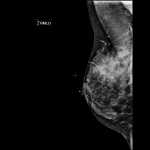Q&A: Are Mammograms Dangerous?

What is the radiation dose of a mammogram? Is it dangerous?
- For digital mammography, the average radiation dose from a standard 4-view mammogram of both breasts is 3.7mGy; for film-screen mammography (not digital), the average dose is 4.7mGy. Data suggests that if there is any risk for developing breast cancer because of screening mammography, it is extremely small. In the Swedish Two County Trial, over 100,000 women have had repeated mammograms since the 1970’s, and the screened group has no more cancers than the group who has not had mammograms. It has been estimated that the theoretical risk of mammography causing a breast cancer is one in one million. That being said, we are quite aware that younger breast tissue is much more sensitive to the effects of ionizing radiation, due to more active cell division. Therefore, we use mammography very carefully in women younger than 35 years old.
If a patient is pregnant or could possibly be pregnant when she presents for a routine screening mammogram, it is prudent to delay screening until after delivery to protect the fetus from unnecessary radiation exposure, or to wait until the patient gets her next period in order to be certain she isn’t pregnant. If the examination cannot be delayed because the patient has a worrisome symptom, the patient’s pelvis is shielded with a lead apron when the mammogram is performed.
Tags: mammogram, Q&A to Honor Pink October 2012, radiation










